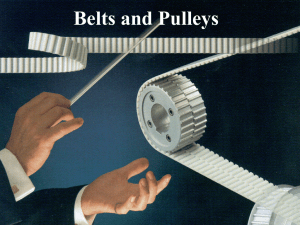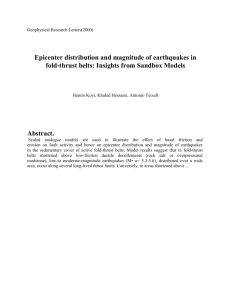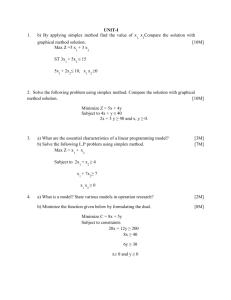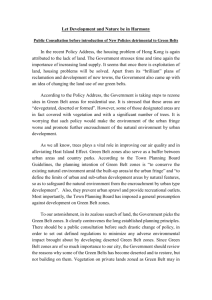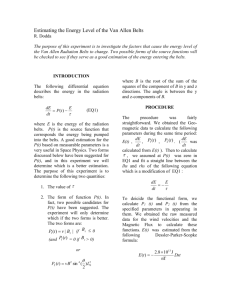File - Why Blomgren Training Systems
advertisement
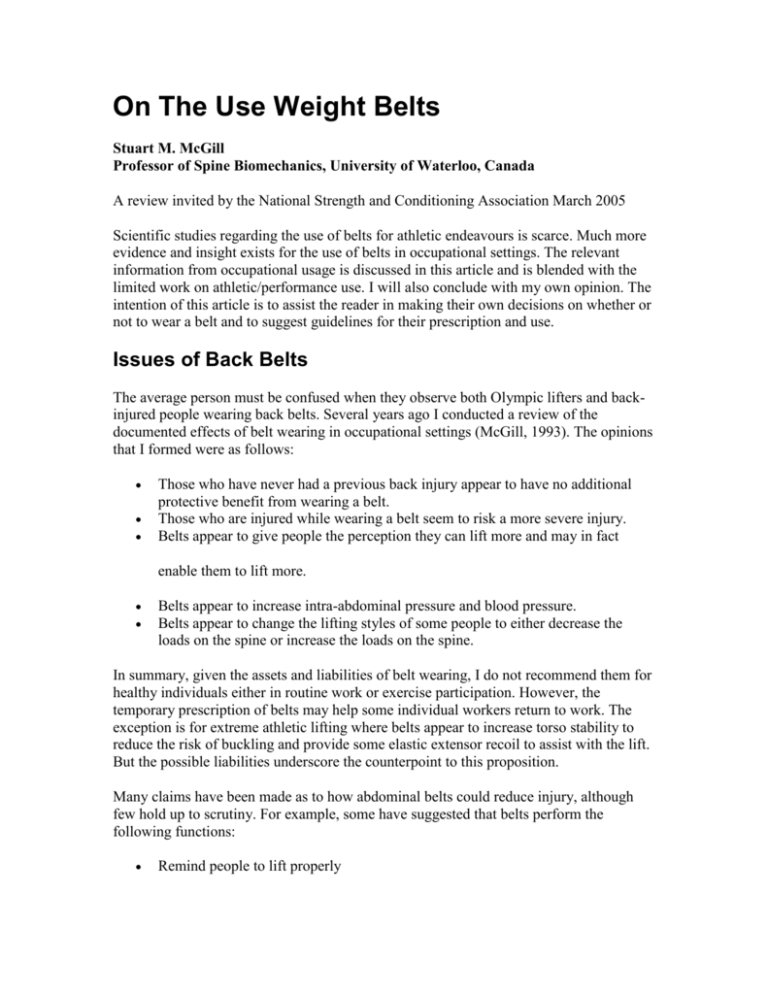
On The Use Weight Belts Stuart M. McGill Professor of Spine Biomechanics, University of Waterloo, Canada A review invited by the National Strength and Conditioning Association March 2005 Scientific studies regarding the use of belts for athletic endeavours is scarce. Much more evidence and insight exists for the use of belts in occupational settings. The relevant information from occupational usage is discussed in this article and is blended with the limited work on athletic/performance use. I will also conclude with my own opinion. The intention of this article is to assist the reader in making their own decisions on whether or not to wear a belt and to suggest guidelines for their prescription and use. Issues of Back Belts The average person must be confused when they observe both Olympic lifters and backinjured people wearing back belts. Several years ago I conducted a review of the documented effects of belt wearing in occupational settings (McGill, 1993). The opinions that I formed were as follows: Those who have never had a previous back injury appear to have no additional protective benefit from wearing a belt. Those who are injured while wearing a belt seem to risk a more severe injury. Belts appear to give people the perception they can lift more and may in fact enable them to lift more. Belts appear to increase intra-abdominal pressure and blood pressure. Belts appear to change the lifting styles of some people to either decrease the loads on the spine or increase the loads on the spine. In summary, given the assets and liabilities of belt wearing, I do not recommend them for healthy individuals either in routine work or exercise participation. However, the temporary prescription of belts may help some individual workers return to work. The exception is for extreme athletic lifting where belts appear to increase torso stability to reduce the risk of buckling and provide some elastic extensor recoil to assist with the lift. But the possible liabilities underscore the counterpoint to this proposition. Many claims have been made as to how abdominal belts could reduce injury, although few hold up to scrutiny. For example, some have suggested that belts perform the following functions: Remind people to lift properly Support shear loading on the spine that results from the effect of gravity acting on the handheld load and mass of the upper body when the trunk is flexed Reduce compressive loading of the lumbar spine through the hydraulic action of increased intra-abdominal pressure associated with belt wearing Act as a splint, reducing the range of motion and thereby decreasing the risk of injury Provide warmth to the lumbar region Enhance proprioception via pressure to increase the perception of stability Reduce muscular fatigue Provide stiffening to the torso to enhance performance Let’s interpret the scientific literature for guidance. Scientific Studies The scientific studies can be divided into clinical trials and those that examined biomechanical, psychophysical, and physiological changes from belt wearing. Clinical Trials: Difficulties in executing a clinical trial clearly exist. The Hawthorne effect is a concern, as it is difficult to present a true double-blind paradigm to participants since those who receive belts certainly know so. In addition, logistical constraints on duration, diversity in occupations, and sample size are problematic. However, the data reported in the better-executed clinical trials cannot support the practice of universal prescription of belts to all workers involved in manual handling of materials to reduce the risk of low-back injury (for example, Reddell and colleagues, 1992, Mitchell and colleagues, 1994, Wassell and colleagues, 2000). Weak evidence suggests that those people already injured might benefit from belts with a reduced risk of injury recurrence. However, evidence does not appear to support uninjured workers wearing belts to reduce the risk of injury; in fact, the risk of injury seems to increase during the period following a trial of belt wearing. Finally, some evidence suggests that the cost of a back injury may be higher in workers who wear belts than in workers who do not. Biomechanical Studies: Researchers who have studied the biomechanical issues of belt wearing have focused on spinal forces, intra-abdominal pressure (IAP), load, and range of motion. The most informative studies are reviewed in this section. Two studies in particular (Harman et al.,1989, and Lander et al., 1992) suggested that wearing a back belt can increase the margin of safety during repetitive lifting. Both of these papers reported ground reaction force and increased intra- abdominal pressure while subjects repeatedly lifted barbells. It was only assumed that intra-abdominal pressure is a good indicator of spinal forces. However, several studies have questioned the hypothesized link between elevated intra-abdominal pressure and reduction in low back load. For example, using an analytical model and data collected from three subjects lifting various magnitudes of loads, McGill and Norman (1987) noted that a buildup of intra-abdominal pressure required additional activation of the musculature in the abdominal wall. This activity resulted in a net increase in low back compressive load and not a net reduction of load, as researchers had previously thought. In addition, Nachemson and colleagues (1986) published some experimental results that directly measured intradiscal pressure during the performance of Valsalva maneuvers, documenting that an increase in intra- abdominal pressure increased, not decreased, the low back compressive load. Therefore, the conclusion that an increase in intra-abdominal pressure due to belt wearing reduces compressive load on the spine seems erroneous. In fact, such an increase may have no effect or may even increase the load on the spine. Several studies have put to rest the belief that IAP affects low back extensor activity. Our own study (McGill and colleagues, 1990) suggested that there was no change in activation levels of the low back extensors nor in any of the abdominal muscles (rectus abdominis or obliques). Both Reyna and colleagues (1995) and Ciriello and Snook (1995) found belts provided no enhancement of function in terms of alleviating the loading of back extensor muscles or fatigue, but these trials were not conducted over a very long period of time. Both Lantz and Schultz (1986) and McGill and colleagues (1994) observed the range of lumbar motions in subjects wearing low back orthoses and belts. Generally, the stiffness of the torso was significantly increased about the lateral bend and axial twist axes when belt wearing but not when subjects were rotated into full flexion. A data set presented by Granata and colleagues (1997) supports the notion that some belt styles are better in stiffening the torso in the manner described previously—namely, the taller elastic belts that span the pelvis to the rib cage. Furthermore, these authors also documented that a rigid orthopedic belt generally increased the lifting moment, while the elastic belt generally reduced spinal load. Even in well controlled studies, belts appear to modulate lifting mechanics in some positive ways in some people and in negative ways in others. Studies of Belts, Heart Rate, and Blood Pressure: Hunter and colleagues (1989) monitored the blood pressure and heart rate of five males and one female performing dead lifts and one-arm bench presses and riding bicycles while wearing and not wearing a 10-cm (4-in.) weight belt. During the lifting exercise, blood pressure (up to 15 mmHg) and heart rate were both significantly higher in subjects wearing belts. Given the relationship between elevated systolic blood pressure and an increased risk of stroke, Hunter and colleagues (1989) concluded that individuals who may have cardiovascular system compromise are probably at greater risk when undertaking exercise while wearing back belts than when not wearing them. Our own work (Rafacz and McGill, 1996) supports these conclusions. Anecdotally, belts and associated pressures may possibly be linked with higher incidents of varicose veins in the testicles, hemorrhoids, and hernias. As of this writing, there has been no scientific and systematic investigation of the validity of these suggestions. It may be prudent to simply state concern and test these ideas in the future. Psychophysical Studies: Some scientists and coaches have expressed concern that wearing belts fosters an increased sense of security that may, or may, not be warranted. Studies based on the psychophysical paradigm allow workers to select weights that they can lift repeatedly using their own subjective perceptions of physical exertion. For example McCoy and colleagues (1988) found that subjects were willing to lift by approximately 19% when wearing a belt. This evidence may lend some support to the theory that belts give people a false sense of security. Summary of Prescription Guidelines for Recreational/Occupational Use While there are guidelines for belt wearing for occupational use, sporting use requires a different approach. Occupational use is based on the premise of injury risk reduction while sporting use includes performance enhancement – to lift more for example. The fundamentals of my recommendations for occupational use (see McGill, 1993, 1999, 2004) presented data and evidence that neither completely supported, nor condemned, the wearing of abdominal/back belts. Given the available literature, it would appear the universal prescription of belts (i.e., providing belts to all workers in an industrial operation) is not in the best interest of globally reducing both the risk of injury and compensation costs. Uninjured workers do not appear to enjoy any additional benefit from belt wearing, and in fact may be exposing themselves to the risk of a more severe injury if they were to become injured. Moreover, they may have to confront the problem of weaning themselves from the belt. However, if some individual workers perceive a benefit from belt wearing, they should be allowed to wear a belt conditionally, but only on trial. The mandatory conditions for occupational/recreational prescription (for which there should be no exception) are as follows: 1. Given the concerns regarding increased blood pressure and heart rate and issues of liability, all candidates for belt wearing should be screened for cardiovascular risk by medical personnel. 2. Given the concern that belt wearing may provide a false sense of security, belt wearers must receive education on lifting mechanics (back school). All too often, belts are being promoted to industry as a quick fix to the injury problem. Promotion of belts, conducted in this way, is detrimental to the goal of reducing injury as it redirects the focus from the cause of the injury. Education programs should include information on how tissues become injured, techniques to minimize musculoskeletal loading, and what to do about feelings of discomfort to avoid disabling injury. 3. Consultants should not prescribe belts until they have conducted a full ergonomic assessment of the individual’s job. The ergonomic approach should examine, and attempt to correct, the cause of the musculoskeletal overload and provide solutions to reduce the excessive loads. In this way, belts should only be used as a supplement for a few individuals, while a greater plant-wide emphasis should be on the development of a comprehensive ergonomics program. 4. Belts should not be considered for long-term use. The objective of any smallscale belt program should be to wean workers from the belts by insisting on mandatory participation in comprehensive fitness programs and education on lifting mechanics, combined with ergonomic assessment. Furthermore, consultants would be wise to continue vigilance in monitoring former belt wearers for a period of time following belt wearing, given that this period appears to be characterized by an elevated risk of injury. Guidelines for Serious Lifting Athletes Much of the occupational evidence has relevance for athletic use of belts. There is no question that belts assist in generating a few more Newton-meters (or foot-pounds) of torque in the torso through elastic recoil of a bent torso that is stiffened with a belt. However, if a neutral spine is preserved throughout the lift this effect is minimal. In other words, to obtain the maximal effect from a belt, the lifter must lift poorly and in a way that exposed the back to a much higher risk of injury! There is no question that belts assist in generating torso stiffness to reduce the risk of spine buckling in extreme heavy lifts. Many athletes working at this edge of the envelope will receive this assist. However, other techniques are employed to maximize the torso stiffness – the lungs are filled to almost the top of tidal volume and the breath is then held. In some tasks, an athlete will only “sip” the air never allowing much air to leave the lungs that would reduce torso stiffness. Belts also increase intra-abdominal pressure which in turn increases the CNS fluid pressure in the spine and, in turn, the brain. This decreases the transmural gradient (the pressure difference between the arterial blood pressure in the brain vessels and the brain itself) which in turn may reduce the risk of aneurysm, or stroke. Others have argued that this effect has detrimental implications for venous return to the heart. I am unaware of any evidence to suggest where the balance lies. There are other counter considerations. Evidence suggests that people change their motor patterns, together with their motion patterns when using a belt. The evidence suggests that these motor control changes can elevate the risk of injury should a belt not be worn in a belt- training athlete. The severity of a back injury may be greater if a belt is worn. Many people adopt belts in training for one of three reasons: They have observed others wearing them and have assumed that it will be a good idea for them to do so. Their backs are becoming sore and they believe that a back belt will help. They want to lift a few more pounds. None of these reasons are consistent with the objective of good health. If one must lift a few more pounds, wear a belt. If one wants to groove motor patterns to train for other athletic tasks that demand a stable torso, it is probably better not to wear one. Instead do the work to perfect lifting technique. Looking forward -A final opinion Training for high performance usually requires high speed movement. Also critical for ultimate performance is timed and coordinated stiffness and joint stability. Consider the golf swing that epitomizes the contrast between controlled relaxed motion through the backswing and violent whole body stiffening at the instant of ball contact only to be followed by more relaxed follow through motion. The same contrast can be generalized for punching power and for the impressive “hit” in football, for example. The best athletes are able to generate motion but know when to stiffen with extremely rapid muscle activation together with rapid muscle relaxation. Techniques for training this skill involve selective plyometric exercise which in my opinion is generally encumbered by wearing a belt. Thus, I modify my opinion for speed training and consider belts inappropriate when used in this way. Adapted from the chapter on back belts by Stuart McGill in: “Ultimate Back Fitness and Performance”, Wabuno publishers, 2004, Canada. Available from www.backfitpro.com
